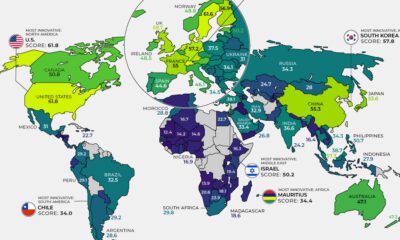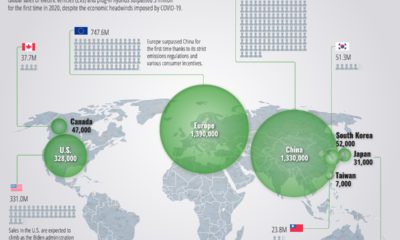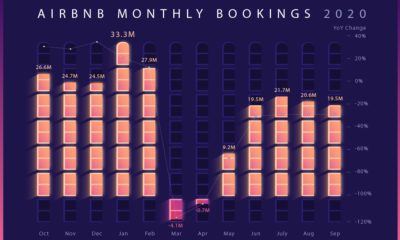This infamous phrase was popularized in the 1992 film Glengarry Glen Ross, and has become a mantra among fervent salespeople. While sealing the deal is always the ultimate goal, salespeople actually spend the majority of their time on other tasks like generating and nurturing prospects, following up with customers, and finding new sales opportunities. For this reason, nearly three-quarters of sales professionals rely on technology to do those less glamorous tasks faster and more efficiently. Today’s graphic from Raconteur shows the value of technology in today’s sales world and how artificial intelligence (AI) technology ultimately helps sales reps win more business.
Artificial Intelligence in Sales
Globally, 40% of salespeople use or are implementing AI technology into their workflows to automate or streamline sales. AI-based sales technology helps to:
Identify the best leads to target using past customer data Improve the quantity and quality of leads Increase omnichannel customer engagement Personalize customer information in real-time Automate sales tasks such as contact information data entry
Using AI tools could mean the difference between closing a deal or losing a prospect. Companies that automated their contact form responses, for example, saw a 71% increase in open rates and a 152% increase in clickthrough rates.
Growth of Sales Technologies and Tools
With at least two dozen major sales tech segments projected to grow in the next few years, five technologies stand to gain the most traction.
- Account and Opportunity Planning Refined data from past and existing customers offer valuable insights on which future prospects to target. Using these insights and other key data (company lists), sales intelligence tools can create custom search criteria to narrow down the best leads to approach. These tools merge seamlessly with analytics, marketing, and data management to prevent information silos within a company.
- Sales Methodology/Workflow Customer relationship management (CRM) is now the fastest-growing software sector in the world. The CRM market is expected to double from $40 billion in 2019 to $80 billion by 2025. Salespeople can use tools like Salesforce to manage leads and customers effectively and even assist other internal teams with more personalized customer interactions, such as customer service.
- Content Management In this information-rich age, companies are expected to keep customer information secure. Content Management Software (CMS) such as Confluence or Paperflite allows sales teams to instantly organize, collaborate on, and distribute internal documents and resources with one another to maintain up-to-date files.
- Prospect Engagement Management Customers want products and services tailored to their specific needs and desires. Many companies using a series of personalized emails to welcome or re-engage online customers found they could close 75% more in sales.
- Online Training and Coaching Delivery With new technologies, more nuanced client data, and shifting public perceptions of brands, top salespeople are seeking out efficient methods to maintain their skills. This helps them to better connect with prospects and manage sales pipelines.
Technology in the Sales Workflow
Top sales professionals have weighed in—sales technology platforms and tools are invaluable to their success. An overwhelming majority of salespeople use these tools every day:
98% use sales intelligence solutions that provide insight and automation. Examples: InsideView, Nimble, Clearbit 94% use collaboration tools to keep their finger on the pulse of sales activities. Examples: Wrike, Basecamp, Slack 92% use email tracking tools to track campaigns and conversions. Examples: Ebsta, Clearslide, Hubspot Sales
Using more refined software tools, salespeople are able to make better-informed decisions about which prospects to nurture and which ones to grow organically. And as Glengarry Glen Ross reminds us: “Coffee’s for closers only.” on But fast forward to the end of last week, and SVB was shuttered by regulators after a panic-induced bank run. So, how exactly did this happen? We dig in below.
Road to a Bank Run
SVB and its customers generally thrived during the low interest rate era, but as rates rose, SVB found itself more exposed to risk than a typical bank. Even so, at the end of 2022, the bank’s balance sheet showed no cause for alarm.
As well, the bank was viewed positively in a number of places. Most Wall Street analyst ratings were overwhelmingly positive on the bank’s stock, and Forbes had just added the bank to its Financial All-Stars list. Outward signs of trouble emerged on Wednesday, March 8th, when SVB surprised investors with news that the bank needed to raise more than $2 billion to shore up its balance sheet. The reaction from prominent venture capitalists was not positive, with Coatue Management, Union Square Ventures, and Peter Thiel’s Founders Fund moving to limit exposure to the 40-year-old bank. The influence of these firms is believed to have added fuel to the fire, and a bank run ensued. Also influencing decision making was the fact that SVB had the highest percentage of uninsured domestic deposits of all big banks. These totaled nearly $152 billion, or about 97% of all deposits. By the end of the day, customers had tried to withdraw $42 billion in deposits.
What Triggered the SVB Collapse?
While the collapse of SVB took place over the course of 44 hours, its roots trace back to the early pandemic years. In 2021, U.S. venture capital-backed companies raised a record $330 billion—double the amount seen in 2020. At the time, interest rates were at rock-bottom levels to help buoy the economy. Matt Levine sums up the situation well: “When interest rates are low everywhere, a dollar in 20 years is about as good as a dollar today, so a startup whose business model is “we will lose money for a decade building artificial intelligence, and then rake in lots of money in the far future” sounds pretty good. When interest rates are higher, a dollar today is better than a dollar tomorrow, so investors want cash flows. When interest rates were low for a long time, and suddenly become high, all the money that was rushing to your customers is suddenly cut off.” Source: Pitchbook Why is this important? During this time, SVB received billions of dollars from these venture-backed clients. In one year alone, their deposits increased 100%. They took these funds and invested them in longer-term bonds. As a result, this created a dangerous trap as the company expected rates would remain low. During this time, SVB invested in bonds at the top of the market. As interest rates rose higher and bond prices declined, SVB started taking major losses on their long-term bond holdings.
Losses Fueling a Liquidity Crunch
When SVB reported its fourth quarter results in early 2023, Moody’s Investor Service, a credit rating agency took notice. In early March, it said that SVB was at high risk for a downgrade due to its significant unrealized losses. In response, SVB looked to sell $2 billion of its investments at a loss to help boost liquidity for its struggling balance sheet. Soon, more hedge funds and venture investors realized SVB could be on thin ice. Depositors withdrew funds in droves, spurring a liquidity squeeze and prompting California regulators and the FDIC to step in and shut down the bank.
What Happens Now?
While much of SVB’s activity was focused on the tech sector, the bank’s shocking collapse has rattled a financial sector that is already on edge.
The four biggest U.S. banks lost a combined $52 billion the day before the SVB collapse. On Friday, other banking stocks saw double-digit drops, including Signature Bank (-23%), First Republic (-15%), and Silvergate Capital (-11%).
Source: Morningstar Direct. *Represents March 9 data, trading halted on March 10.
When the dust settles, it’s hard to predict the ripple effects that will emerge from this dramatic event. For investors, the Secretary of the Treasury Janet Yellen announced confidence in the banking system remaining resilient, noting that regulators have the proper tools in response to the issue.
But others have seen trouble brewing as far back as 2020 (or earlier) when commercial banking assets were skyrocketing and banks were buying bonds when rates were low.













